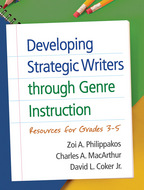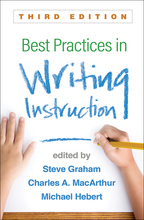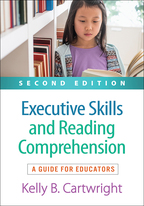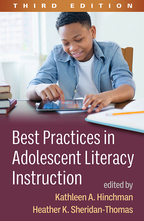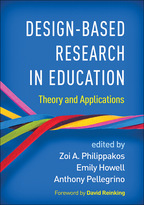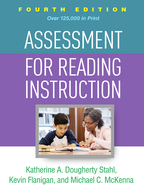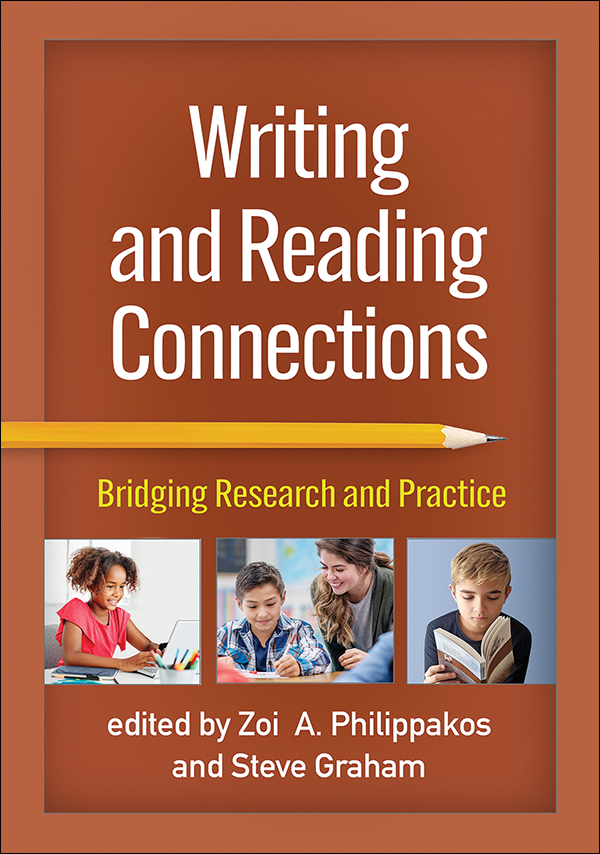Writing and Reading Connections
Bridging Research and Practice
Edited by Zoi A. Philippakos and Steve Graham
Foreword by Jill Fitzgerald
HardcoverPaperbacke-bookprint + e-book
Hardcover
orderDecember 21, 2022
ISBN 9781462550500
Price: $62.00 340 Pages
Size: 7" x 10"
Paperback
orderNovember 18, 2022
ISBN 9781462550463
Price: $41.00340 Pages
Size: 7" x 10"
e-book
orderOctober 13, 2022
PDF and Accessible ePub ?
Price: $41.00 340 Pages
ePub is Global Certified Accessible
print + e-book $82.00 $49.20
orderPaperback + e-Book (PDF and Accessible ePub) ?
Price: 340 Pages
ePub is Global Certified Accessible
Sign up for emails on upcoming titles by Steve Graham (with special discounts)!
“The book stays true to its title—it does bridge research and practice!...The book is reader friendly and easily accessible for readers regardless of whether they are teachers, students, or researchers. As a book about writing–reading connections, it is a pleasure that the chapters are written by authors aware of their readers. This is evident in the concise language and the common structure of the chapters. It is particularly useful with questions at the beginning of each chapter guiding the reading process and questions at the end of each chapter inspiring reflection and action.”

—Journal of Writing Research
“One of the most important but underappreciated domains of literacy research is the link between reading and writing. Philippakos and Graham fill a chasm in literacy theory and research by assembling scholars who have devoted their careers to exploring writing–reading connections. I will use this book in my graduate-level literacy classes for both emerging researchers and future teachers. With its coverage of components and domains of literacy, applications to content-area instruction, and addressing the strengths and needs of distinct populations, this book does the literacy field a great service!”

—C. Patrick Proctor, EdD, Lynch School of Education and Human Development, Boston College
“Putting research to work, this text is designed to help educators see the complex connections between writing and reading needed to build effective learning opportunities for K–12 students. Establishing itself as the most current resource on this topic, the book is written and edited by leading scholars and researchers. It addresses the history of writing and reading instruction, elements essential to comprehensive literacy instruction, and the use of writing to support learning in multiple academic and learning contexts. The editors ensure their book is inclusive and relevant for educators working with a wide range of learner populations.”

—Susan De La Paz, PhD,College of Education, University of Maryland
“This book does an excellent job of establishing the interrelation of reading and writing. Chapters demonstrate what a network of reading and writing practices looks like in a classroom, how this network can inform instruction, and how this can make the school experience more meaningful to and valued by students. I especially like how the chapters capture such a wide range of compelling issues and topics. I would assign this entire book or selected chapters in a range of secondary education courses on writing.”

—George E. Newell, PhD, Department of Teaching and Learning (Emeritus), The Ohio State University
“Elementary and secondary teachers often struggle to balance reading and writing instruction. This book provides educators a clear rationale for why writing and reading should be integrated in the classroom, specific guidance for using writing–reading connections to achieve important literacy goals, and practical, research-validated approaches for leveraging these processes to build disciplinary knowledge and skills. This book is an invaluable tool for teachers, teacher educators, and professional developers who recognize writing, reading, and oral discourse as essential elements of students’ learning, and who want to take advantage of the powerful synergy of these processes.”

—William E. Lewis, PhD, School of Education, University of Delaware
—Journal of Writing Research
“One of the most important but underappreciated domains of literacy research is the link between reading and writing. Philippakos and Graham fill a chasm in literacy theory and research by assembling scholars who have devoted their careers to exploring writing–reading connections. I will use this book in my graduate-level literacy classes for both emerging researchers and future teachers. With its coverage of components and domains of literacy, applications to content-area instruction, and addressing the strengths and needs of distinct populations, this book does the literacy field a great service!”
—C. Patrick Proctor, EdD, Lynch School of Education and Human Development, Boston College
“Putting research to work, this text is designed to help educators see the complex connections between writing and reading needed to build effective learning opportunities for K–12 students. Establishing itself as the most current resource on this topic, the book is written and edited by leading scholars and researchers. It addresses the history of writing and reading instruction, elements essential to comprehensive literacy instruction, and the use of writing to support learning in multiple academic and learning contexts. The editors ensure their book is inclusive and relevant for educators working with a wide range of learner populations.”
—Susan De La Paz, PhD,College of Education, University of Maryland
“This book does an excellent job of establishing the interrelation of reading and writing. Chapters demonstrate what a network of reading and writing practices looks like in a classroom, how this network can inform instruction, and how this can make the school experience more meaningful to and valued by students. I especially like how the chapters capture such a wide range of compelling issues and topics. I would assign this entire book or selected chapters in a range of secondary education courses on writing.”
—George E. Newell, PhD, Department of Teaching and Learning (Emeritus), The Ohio State University
“Elementary and secondary teachers often struggle to balance reading and writing instruction. This book provides educators a clear rationale for why writing and reading should be integrated in the classroom, specific guidance for using writing–reading connections to achieve important literacy goals, and practical, research-validated approaches for leveraging these processes to build disciplinary knowledge and skills. This book is an invaluable tool for teachers, teacher educators, and professional developers who recognize writing, reading, and oral discourse as essential elements of students’ learning, and who want to take advantage of the powerful synergy of these processes.”
—William E. Lewis, PhD, School of Education, University of Delaware


